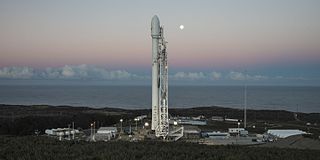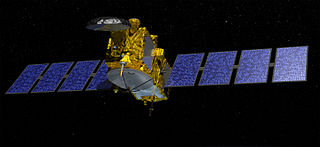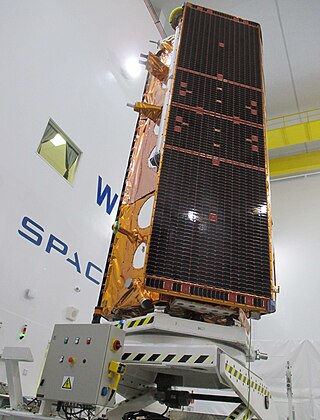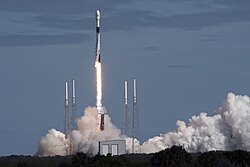
Falcon 9 is a partially reusable, human-rated, two-stage-to-orbit, medium-lift launch vehicle designed and manufactured in the United States by SpaceX. The first Falcon 9 launch was on 4 June 2010, and the first commercial resupply mission to the International Space Station (ISS) launched on 8 October 2012. In 2020, it became the first commercial rocket to launch humans to orbit. The Falcon 9 has an exceptional safety record, with 392 successful launches, two in-flight failures, one partial failure and one pre-flight destruction. It is the most-launched American orbital rocket in history.

SAOCOM is an Earth observation satellite constellation of Argentina's space agency CONAE. Two satellites are already orbiting the Earth in a Sun-synchronous orbit. The second one was launched on 30 August 2020.

Space Launch Complex 4 (SLC-4) is a launch and landing site at Vandenberg Space Force Base, California, U.S. It has two pads, both of which are used by SpaceX for Falcon 9, one for launch operations, and the other as Landing Zone 4 (LZ-4) for SpaceX landings.

Jason-3 is a satellite altimeter created by a partnership of the European Organisation for the Exploitation of Meteorological Satellites (EUMETSAT) and National Aeronautic and Space Administration (NASA), and is an international cooperative mission in which National Oceanic and Atmospheric Administration (NOAA) is partnering with the Centre National d'Études Spatiales. The satellite's mission is to supply data for scientific, commercial, and practical applications to sea level rise, sea surface temperature, ocean temperature circulation, and climate change.

SpaceX has privately funded the development of orbital launch systems that can be reused many times, similar to the reusability of aircraft. SpaceX has developed technologies over the last decade to facilitate full and rapid reuse of space launch vehicles. The project's long-term objectives include returning a launch vehicle first stage to the launch site within minutes and to return a second stage to the launch pad, following orbital realignment with the launch site and atmospheric reentry in up to 24 hours. SpaceX's long term goal would have been reusability of both stages of their orbital launch vehicle, and the first stage would be designed to allow reuse a few hours after return. Development of reusable second stages for Falcon 9 was later abandoned in favor of developing Starship. However, SpaceX still developed reusable payload fairings for the Falcon 9.

Falcon 9 flight 10 was a Falcon 9 space launch that occurred on July 14, 2014. It was the fifth launch of the Falcon 9 v1.1 launch vehicle and carried six Orbcomm-OG2 telecommunication satellites. All six 172-kilogram-mass (379 lb) satellites were successfully deployed.

An autonomous spaceport drone ship (ASDS) is a modified ocean-going barge equipped with propulsion systems to maintain precise position and a large landing platform. SpaceX developed these vessels to recover the first stage of its launch vehicles. By recovering and reusing these boosters, SpaceX has significantly reduced the cost of space launch.

Falcon 9 Full Thrust is a partially reusable, two-stage-to-orbit, medium-lift launch vehicle designed and manufactured in the United States by SpaceX. It is the third major version of the Falcon 9 family, designed starting in 2014, with its first launch operations in December 2015. It was later refined into the Block 4 and Block 5. As of 11 November 2024, all variants of the Falcon 9 Full Thrust had performed 375 launches with only one failure: Starlink Group 9-3.

Paz is a Spanish Earth observation and reconnaissance satellite launched on 22 February 2018. It is Spain's first spy satellite. The satellite is operated by Hisdesat. Paz was previously referred to as SEOSAR.

Falcon 9 B1046 was a reusable Falcon 9 first-stage booster manufactured by SpaceX. It flew four times between 2018 and 2020 before it was expended during a successful abort test of the Crew Dragon. It was the first rocket of the final Falcon 9 upgrade, Block 5.

Starship is a two-stage fully reusable super heavy-lift launch vehicle under development by American aerospace company SpaceX. On April 20, 2023, with the first Integrated Flight Test, Starship became the most massive and most powerful vehicle ever to fly. SpaceX has developed Starship with the intention of lowering launch costs using economies of scale, aiming to achieve this by reusing both rocket stages by "catching" them with the launch tower's systems, increasing payload mass to orbit, increasing launch frequency, mass-manufacturing the rockets and adapting it to a wide range of space missions. Starship is the latest project in SpaceX's reusable launch system development program and plan to colonize Mars.

Falcon 9 Block 5 is a partially reusable, human-rated, two-stage-to-orbit, medium-lift launch vehicle designed and manufactured in the United States by SpaceX. It is the fifth major version of the Falcon 9 family and the third version of the Falcon 9 Full Thrust. It is powered by Merlin 1D engines burning rocket-grade kerosene (RP-1) and liquid oxygen (LOX).

Falcon 9 booster B1056 was a reusable Falcon 9 Block 5 first-stage booster manufactured by SpaceX. The booster was the fourth Falcon 9 to fly four times and broke a turnaround record for an orbital class booster on its fourth flight. The booster's service came to an end on its fourth flight following a landing failure on a Starlink flight.

Falcon 9 booster B1058 was a reusable Falcon 9 Block 5 first-stage booster manufactured by SpaceX. B1058 was the first Falcon 9 booster to fly fourteen, fifteen, sixteen, seventeen, eighteen and nineteen times and broke a turnaround record on its later flights. Its first flight was for Crew Dragon Demo-2, the first crewed orbital spaceflight by a private company. The booster was the first and only Falcon 9 booster to feature NASA's worm logo and meatball insignia, which was reintroduced after last being used in 1992. The booster was destroyed after successfully landing on the autonomous spaceport drone ship, Just Read the Instructions. B1058 toppled over as the drone ship sailed toward Port Canaveral in rough seas.

Falcon 9 B1060 was a Falcon 9 first-stage booster manufactured and operated by SpaceX. It was the senior active booster vehicle for the company since the demise of B1058 on 25 December 2023 during transit back to shore, until being expended for the Galileo FOC FM25 & FM27 mission on 28 April 2024. It had flown 20 missions and landed 19 times.

















